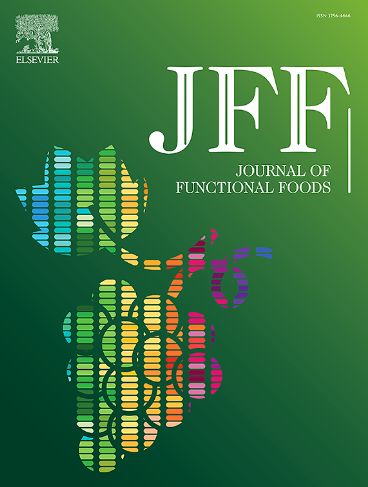Proteome analysis reveals the molecular mechanisms of fucoxanthin-induced apoptosis in glial cells PC12 after nanoencapsulation
IF 3.8
2区 农林科学
Q2 FOOD SCIENCE & TECHNOLOGY
引用次数: 0
Abstract
Fucoxanthin (FX) is a natural pigment belonging to the xanthophyll carotenoid, which has been proven to have inhibitory effects on glioblastoma. In our previous study, nano-FX was fabricated through whey protein and flaxseed gum co-encapsulated for improved stability and glial cell (PC12) inhibitory activity of FX. To investigate the molecular mechanisms of FX-induced apoptosis in PC12 after nanoencapsulation, proteomics analysis based on TMT technology was performed. Protein profiles in PC12 were determined after 0 (Control), 8 (L_Treat), and 24 (H_Treat) μg/mL nano-FX intervention. Results indicated 78 differential abundant proteins (DAPs) linked to the cytotoxicity of nano-FX could be potential biomarkers. GO and KEGG analysis revealed altered proteasome and NF-kappa B/MAPK/TNF. Proteins involved in cell proliferation were downregulated, while proteins response to autophagy and apoptosis were upregulated. The multiple mechanisms involved in the anti-tumor activity of nano-FX will provide a reference for the development of FX high value-added functional foods.

蛋白质组学分析揭示了岩藻黄素纳米包封后诱导神经胶质细胞PC12凋亡的分子机制
岩藻黄素(FX)是一种天然色素,属于叶黄素类胡萝卜素,已被证明对胶质母细胞瘤有抑制作用。在我们之前的研究中,我们通过乳清蛋白和亚麻籽胶共包被来制备纳米FX,以提高FX的稳定性和胶质细胞(PC12)抑制活性。为了研究fx诱导PC12纳米包封后细胞凋亡的分子机制,我们采用基于TMT技术的蛋白质组学分析。在0 (Control)、8 (L_Treat)和24 (H_Treat) μg/mL的纳米fx干预下,检测PC12蛋白谱。结果表明,与纳米fx细胞毒性相关的78个差异丰富蛋白(DAPs)可能是潜在的生物标志物。GO和KEGG分析显示蛋白酶体和nf - κ B/MAPK/TNF发生改变。参与细胞增殖的蛋白被下调,而响应自噬和凋亡的蛋白被上调。纳米FX抗肿瘤活性的多种机制将为开发FX高附加值功能食品提供参考。
本文章由计算机程序翻译,如有差异,请以英文原文为准。
求助全文
约1分钟内获得全文
求助全文
来源期刊

Journal of Functional Foods
FOOD SCIENCE & TECHNOLOGY-
CiteScore
9.60
自引率
1.80%
发文量
428
审稿时长
76 days
期刊介绍:
Journal of Functional Foods continues with the same aims and scope, editorial team, submission system and rigorous peer review. We give authors the possibility to publish their top-quality papers in a well-established leading journal in the food and nutrition fields. The Journal will keep its rigorous criteria to screen high impact research addressing relevant scientific topics and performed by sound methodologies.
The Journal of Functional Foods aims to bring together the results of fundamental and applied research into healthy foods and biologically active food ingredients.
The Journal is centered in the specific area at the boundaries among food technology, nutrition and health welcoming papers having a good interdisciplinary approach. The Journal will cover the fields of plant bioactives; dietary fibre, probiotics; functional lipids; bioactive peptides; vitamins, minerals and botanicals and other dietary supplements. Nutritional and technological aspects related to the development of functional foods and beverages are of core interest to the journal. Experimental works dealing with food digestion, bioavailability of food bioactives and on the mechanisms by which foods and their components are able to modulate physiological parameters connected with disease prevention are of particular interest as well as those dealing with personalized nutrition and nutritional needs in pathological subjects.
 求助内容:
求助内容: 应助结果提醒方式:
应助结果提醒方式:


